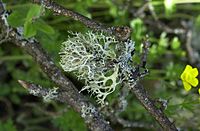
Photo from wikipedia
This study compared the ability of the lichen Evernia prunastri, chitin and chitosan to take up Cu2+ and Zn2+. It was hypothesized that chitin and chitosan have an accumulation capacity… Click to show full abstract
This study compared the ability of the lichen Evernia prunastri, chitin and chitosan to take up Cu2+ and Zn2+. It was hypothesized that chitin and chitosan have an accumulation capacity comparable to the lichen, so that these biopolymers could replace the use of E. prunastri for effective biomonitoring of Cu and Zn air pollution. Samples of the lichen E. prunastri, as well as chitin (from shrimps) and chitosan (from crabs), were incubated with Cu and Zn solutions at concentrations of 0 (control), 10, 25, 50, 75, and 100 µM and analyzed by Inductively Coupled Plasma Mass Spectrometry (ICP-MS). Metal concentrations accumulated by lichen, chitin and chitosan samples were strongly and linearly correlated with the concentrations in the treatment solutions. The lichen always showed significantly higher accumulation values compared to chitin and chitosan, which showed similar accumulation features. The outcomes of this study confirmed the great effectiveness of the lichen Evernia prunastri for environmental biomonitoring and showed that chitin and chitosan have a lower accumulation capacity, thus suggesting that although these biopolymers have the potential for replacing E. prunastri in polluted areas, their suitability may be limited in areas with intermediate or low pollution levels.
Journal Title: Biology
Year Published: 2020
Link to full text (if available)
Share on Social Media: Sign Up to like & get
recommendations!